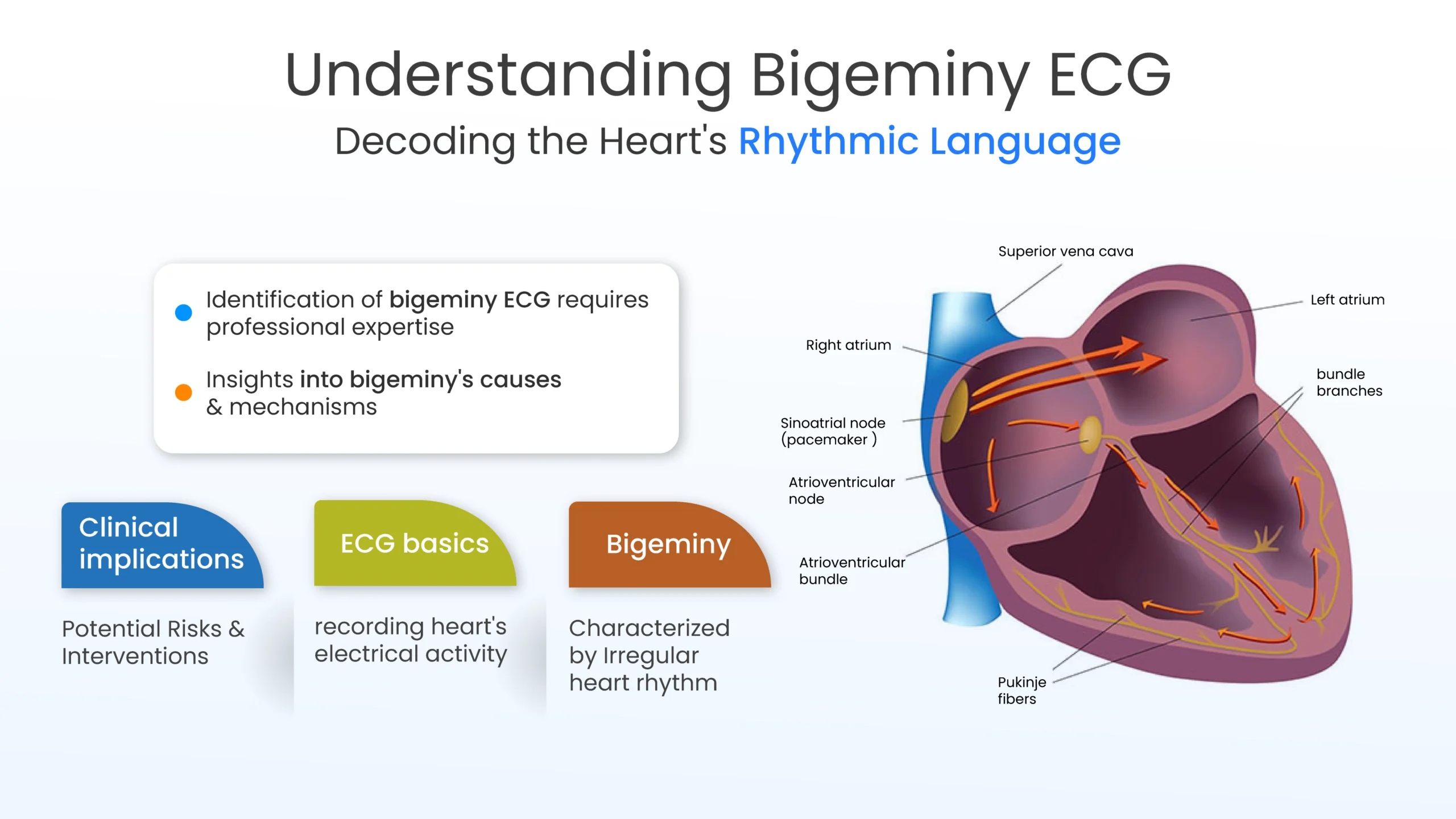
Author:- Mr. Ritesh Sharma
In the realm of heart health, the electrocardiogram is paramount. This single test is capable of detecting a multitude of heart abnormalities. Bigeminy ECG is an integral part of this screening test. Bigeminy, derived from the Latin word “bi-” meaning two, and “Gemini” meaning twins, paints a vivid picture of its essence. It is shown as a rhythmic pattern where every normal heartbeat is followed by a premature contraction, creating a distinctive two-in-one sequence. This irregularity often poses diagnostic challenges and warrants a closer examination of the heart’s electrical dynamics.
Detecting bigeminy ECG requires a trained healthcare professional. This abnormality while being not too dangerous poses a challenge in detecting. So, what exactly is bigeminy ECG? What are its clinical implications and preventive measures? Let’s try to find out all this through this blog.
Introduction to the ECG Landscape
Before delving into the specifics of bigeminy, it is essential to grasp the basics of an ECG. At its core, an ECG records the heart’s electrical signals through electrodes placed on the body’s surface. These signals, translated into waveforms, depict the depolarization and repolarization of cardiac muscles, offering insights into rhythm, conduction, and abnormalities.
Typically, a standard ECG showcases a repetitive pattern of P waves, QRS complexes, and T waves, reflecting the sequential activation and recovery of the chambers of the heart. Any deviation from this norm can signify an underlying pathology, guiding clinicians toward an accurate diagnosis.
What is Bigeminy ECG?
Bigeminy acts like a disruption in the symphony of the heart rhythm. In this, the heart normally beats at once and then a premature contraction disrupts it. This is showcased on an ECG as an abnormality. This abnormality is known as bigeminy ECG. The premature contraction is hard to see on an ECG, as it only occurs for a fleeting period. It is much different from ventricular trigeminy in which the premature contractions are more evident and can be vividly seen through an ECG.
The key to recognizing bigeminy lies in its regularity, or rather, its irregular regularity. Unlike some cardiac arrhythmias of different arrhythmia classifications characterized by chaotic fluctuations showcasing an abnormal ECG, bigeminy adheres to a consistent cadence, alternating between normal and premature beats in a predictable fashion. This rhythmic uniformity serves as a crucial diagnostic clue, prompting further investigation into its underlying causes.
Insights into Bigeminy's Origins
Behind the enigmatic facade of bigeminy lie several mechanisms orchestrating its symphony of irregularity. One of the primary culprits is enhanced automaticity, where cardiac cells exhibit heightened excitability, triggering premature contractions independent of the sinoatrial (SA) node’s control. This phenomenon often stems from electrolyte imbalances, sympathetic stimulation, or myocardial ischemia, each imposing its unique imprint on the heart’s electrical landscape.
Another contributor to bigeminy is re-entry, a phenomenon wherein electrical impulses circulate within cardiac tissues, perpetuating a cycle of premature depolarizations. This re-entrant circuitry, fueled by abnormalities in conduction pathways or structural defects, can induce a rhythmic interplay between normal and premature beats, characteristic of bigeminy’s signature pattern.
Clinical Implications
From a clinical perspective, bigeminy serves as both a diagnostic puzzle and a prognostic indicator. Its presence on an ECG warrants a comprehensive evaluation to discern its underlying etiology and assess its implications for patient health.
In some cases, bigeminy may arise as an isolated phenomenon, benign in nature and requiring minimal intervention beyond monitoring and lifestyle modifications. However, its association with underlying cardiac pathologies, such as coronary artery disease, electrolyte imbalances, or structural abnormalities, necessitates a thorough investigation to mitigate potential risks and tailor treatment strategies accordingly.
Moreover, the persistence of bigeminy can predispose individuals to more serious arrhythmias, such as ventricular tachycardia or fibrillation, highlighting the importance of vigilant monitoring and proactive management. Timely intervention, guided by an understanding of bigeminy’s mechanisms and clinical implications, can mitigate risks and optimize patient outcomes in the long run.
In conclusion, bigeminy ECG emerges as a unique entity, characterized by its rhythmic duality and enigmatic origins. Understanding its nuances requires a holistic approach, integrating knowledge of cardiac physiology, electrophysiology, and clinical correlations.
As clinicians, researchers, and healthcare providers navigate the terrain of bigeminy ECG, they embark on a journey of discovery, unraveling its mysteries one waveform at a time. With each insight gained, they move closer to deciphering the heart’s rhythmic language and unlocking new avenues for diagnosis, treatment, and prevention.
In the realm of cardiac diagnostics, bigeminy stands as a testament to the intricate interplay between form and function, where irregularity begets insight, and understanding paves the path toward better patient care and outcomes.



